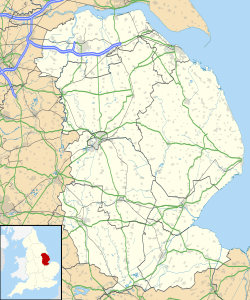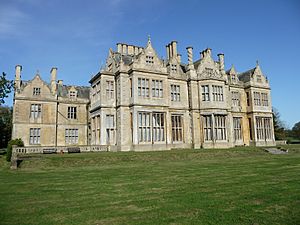Revesby Abbey facts for kids
| Monastery information | |
|---|---|
| Full name | The Abbey Church of St Laurence, Revesby |
| Order | Cistercian |
| Established | 1143 |
| Disestablished | c.1539 |
| Mother house | Rievaulx Abbey |
| Dedicated to | St Mary and St Laurence |
| Diocese | Diocese of Lincoln |
| Controlled churches | Revesby, Scithesby, Hagnaby, Frodingham, Theddlethorpe |
| People | |
| Founder(s) | William de Roumare, Earl of Lincoln |
| Site | |
| Location | Revesby, Lincolnshire, England |
| Coordinates | 53°07′42″N 0°03′37″W / 53.12833°N 0.06028°W |
| Visible remains | earthworks |
| Public access | no |
Revesby Abbey was a Cistercian monastery. It was located near the village of Revesby in Lincolnshire, England. A monastery is a place where monks live and worship.
The abbey was started in 1143 by William de Roumare, Earl of Lincoln. The very first monks came from Rievaulx Abbey in Yorkshire. Later, in the 16th century, the abbey was pulled down. This happened during a time when many monasteries were closed down in England. A large country house was built on the site instead. The house you see today was built in the mid-1800s. It has been empty since the 1960s and needs a lot of repairs.
Contents
History of Revesby Abbey
Revesby Abbey was founded in 1142 by William de Roumare, Earl of Lincoln. He was a powerful noble who later became a monk at the abbey himself. He was also buried there after he died. The first monks came from Rievaulx Abbey, which was another important monastery.
William de Roumare gave the abbey land in places like Revesby, Scithesby, and Thoresby. He also gave them the right to choose priests for the churches in Hagnaby and Scithesby. This right was called an advowson.
Around the mid-1100s, the monks of Revesby offered land to people living in Stichesby and Thoresby. They asked these families to move to other villages. All 13 families from Stichesby and all 11 from Thoresby left. This meant both of these settlements became empty.
In the 1300s, the abbey gained control of the manor of Mareham. A manor was a large estate with land and villages. The abbey was also allowed to hold a weekly market and a yearly fair there. This helped them earn money.
By 1534, the abbey was quite rich. It had an income of over £1,287. This was a lot of money back then. The abbey controlled many manors, including Claxby, East Keal, and Sibsey. However, it seems the abbey's money was not managed well. In 1538, a letter said the abbey was "in great ruin and decay."
The abbey was officially closed down around 1539. This was part of the Dissolution of the Monasteries. During this time, King Henry VIII closed many religious houses in England.
After the Abbey Was Closed
After the abbey was closed, its land and buildings changed hands many times. It was owned by important people like Charles Brandon, 1st Duke of Suffolk. Later, it was sold to William Cecil, 1st Baron Burghley, who was a chief advisor to Queen Elizabeth I.
The estate then stayed in his family for a while. It passed down to his son, the 1st Earl of Exeter, and then to his grandson, the 2nd Earl of Exeter. Through marriages, the estate eventually came into the Howard family.
The Country House at Revesby
Like many former abbey sites, Revesby was turned into a large country house.
Craven Howard, who died in 1700, built a new house on the former abbey land. This house was not built directly on top of the old monastery ruins. His son, Henry Howard, 11th Earl of Suffolk, inherited this new house and the estate.
In 1711, Henry sold the house and its 2,000 acres of land for £14,000. This was considered a very good deal for the buyer. The new owner was Joseph Banks I. He set up his son, Joseph Banks II, at the house. The land was worth about £900 a year in income.
The gardens around the house were greatly improved in the mid-1700s. In the late 1700s, the famous botanist Sir Joseph Banks lived here. He was known for sailing around the world with Captain Cook.
The Current Revesby Abbey House
The house standing today, also called Revesby Abbey, was built in 1845. It was designed in a style called "Jacobethan" by an architect named William Burn. It was built for James Banks Stanhope. It seems the house was built completely new. The furniture and other items from the older house were sold off in 1843 and 1844. However, the basement of the current house uses much older bricks. These bricks are believed to be from Craven Howard's house.
Today, the house is a Grade I listed building. This means it is a very important historical building. However, it is in a "very bad" state and is on Historic England's Heritage at Risk Register. This means it is in danger of falling apart quickly. The current owners live in the stable block nearby and are working on repairs.
The house has been empty since at least 1968. In 1977, the owner at the time wanted to pull the house down, but permission was not given. In 1987, English Heritage stepped in to do urgent repairs because the owner was not doing them. The house was then put up for sale. It changed hands a few times until the current owners bought it in 1999. They have made good progress on its repair.
What's Left of the Medieval Abbey
Today, you cannot see any parts of the original medieval abbey above ground. It was located southwest of the current house and the village of Revesby. When people dug there in 1869, they only found the abbey church and the cloister. A cloister is an open courtyard, usually with covered walkways. In 1870, the skeletons of several monks were found.
However, you can still see signs of the abbey on the ground. These are called "earthworks." They show where the abbey's area used to be. They also reveal the location of three rectangular fishponds that the monks used.



